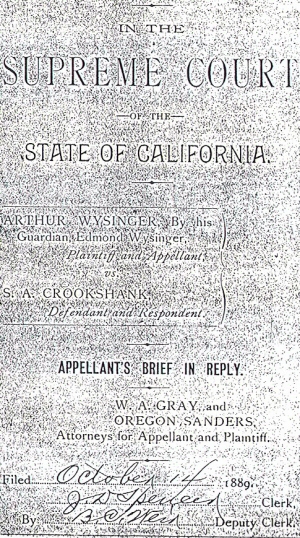Edmond Edward Wysinger facts for kids
Edmond Edward Wysinger (1816–1891) was an important African American pioneer in California. He arrived around October 1849, right when the California Gold Rush was starting. He is remembered for fighting for equal education for his son.
Fighting for Equal Schools
On January 29, 1890, a big court case happened in Visalia, California. It was called Wysinger vs. Crookshank. The California Supreme Court made a very important decision. They ruled that public schools in California could not have separate schools just for children of African descent.
In 1862, Visalia was a town with strong disagreements because of the American Civil War (1861–1865). Many people in Visalia supported the South. Even with this tension, Wysinger stayed in the community.
Wysinger taught himself many things. He worked as a laborer and sometimes as a preacher. He believed that education was very important for his children. He tried to enroll his son, Arthur, in a regular public school. But the school refused to let Arthur in.
Because of this, Wysinger decided to take legal action. He filed a lawsuit against the county school board in October 1888. On March 1, 1890, the California Supreme Court made its final decision. They overturned a lower court's ruling. The court ordered that 12-year-old Arthur Wysinger must be allowed into Visalia's regular school system.
This ruling meant that the state's laws did not allow school boards to separate children based on their race. The court said that if people wanted separate schools, new laws would need to be made. But in 1890, the existing laws did not permit such separation for Black or Native American children.
Edmond Wysinger's Life Story
Edmond Wysinger was one of the first African Americans to travel to California from the Southern United States. He was born in 1816. His mother was a Cherokee woman, and his father was a Black man.
In early 1849, when he was 32 years old, Wysinger made a long and difficult journey. He traveled with his German owner by ox-team Conestoga wagon. They went through Native American lands and over Donner Pass. They arrived in Grass Valley, California, around October 1849. This was during the busiest time of the California Gold Rush. Wysinger took the last name of his slave owner. His original Native American name was Bush.
After arriving in California's gold mining area, Wysinger joined many other African American miners. There were over 100 Black miners working in places like Morman and Mokelumne Hill. They also mined at Placerville and Grass Valley. Mokelumne Hill was often called "Moke Hill." This area was first home to the Miwok Native American tribe. Their name "Mokelumne" means "people of Mokel." "Moke Hill" grew quickly after gold was found in 1848.
Some places in California were named after the presence of Black people. Examples include Negro Hill, Negro Bar, and Negro Flat. Negro Bar was a large sand bar on the lower American River. Wysinger mined in many places, including Mokelumne, Murphy's Camp, Diamond, and Mud Springs. It took him about a year to earn enough money to buy his freedom for $1,000.
In 1853, Alfred and Susan Hines Wilson arrived in Miles Creek in Mariposa County, California. They had traveled from Wayne County in Missouri, going through Texas first. Their journey to California by ox-team lasted from March to December 1853. There were more than 100 wagons in their group. In Merced, Edmond Wysinger met and married their daughter, Penecia.
Around 1862, the Wysinger family moved to Visalia, California. They had eight children there. Their six boys were Jesse, Arthur, James, Reuben, Hervey, and Marion. Their two girls were Martha and Bertha.


